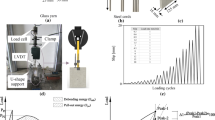Abstract
Fabric reinforced cement composites are a new class of cementitious materials with enhanced tensile strength and ductility. The reinforcing mechanisms of 2-D fabric structures in cement matrix are studied using a fabric pullout model based on nonlinear finite difference method. Three main aspects of the composite are evaluated: nonlinear bond slip characteristic at interface; slack in longitudinal warp yarns, and mechanical anchorage provided by cross yarn junctions. Parametric studies of these key parameters indicate that an increase in the interfacial bond strength directly increases the pullout strength. Grid structures offering mechanical anchorage at cross yarn junctions can substantially increase the pullout resistance. Presence of slack in the yarn geometry causes an apparently weaker and more compliant pullout response. The model was calibrated using a variety of test data on the experimental pullout response of AR-Glass specimens, manufactured by different techniques to investigate the relative force contribution from bond at interface and from cross yarn junctions of alkaline resistant glass fabric reinforced cement composites.













Similar content being viewed by others
References
Peled A, Mobasher B (2005) Pultruded fabric-cement composites. ACI Mater J 102(1):15–23
Kelly A, Tyson WR (1965) Fiber-strengthened materials. Proc. high-strength materials, proceedings of the second Berkeley international materials conference: high-strength materials—present status and anticipated developments. Berkeley, CA, pp 578–602
Stang H, Li Z, Shah SP (1990) Pullout problem: stress versus fracture mechanical approach. J Eng Mech 116(10):2136–2149. doi:10.1061/(ASCE)0733-9399(1990)116:10(2136)
Naaman AE, Namur GG, Alwan JM, Najm HS (1991) Fiber pull-out and bond slip. I: analytical study. II: experimental validation. J Struct Eng 117(9):2769–2800. doi:10.1061/(ASCE)0733-9445(1991)117:9(2769)
Mobasher B, Li CY (1995) Modeling of stiffness degradation of the interfacial zone during fiber debonding. Compos Eng 5:1349–1365
Shao Y, Ouyand C, Shah SP (1998) Interface behavior in steel fiber/cement composites under tension. J Eng Mech 124:1037–1044. doi:10.1061/(ASCE)0733-9399(1998)124:9(1037)
Sueki S (2003) An analytical and experimental study of fabric-reinforced cement-based laminated composites. MS Thesis, Arizona State University
Zastrau B, Richter M, Lepenies I (2003) On the analytical solution of pullout phenomena in textile reinforced concrete. J Eng Mater Technol 125:38–43. doi:10.1115/1.1526125
Peled A, Bentur A (2003) Quantitative description of the pull-out behavior of crimped yarns from cement matrix. J Mater Civ Eng 15(6):537–544. doi:10.1061/(ASCE)0899-1561(2003)15:6(537)
Peld A, Sueki S, Mobasher B (2006) Bonding in fabric-cement systems: effects of fabrication methods. Cement Concr Res 36:1661–1671. doi:10.1016/j.cemconres.2006.05.009
Sueki S, Soranakom C, Mobasher B, Peled A (2007) A pullout-slip response of fabrics embedded in a cement paste matrix. J Mater Civ Eng 104(4):933–941
Banholzer B, Brameshuber W, Jung W (2005) Analytical simulation of pull-out tests—the direct problem. Cement Concr Compos 27(1):93–101. doi:10.1016/j.cemconcomp.2004.01.006
Xu S, Kruger M, Reinhardt HW, Ozbolt J (2004) Bond characteristics of carbon, alkali resistant glass, and aramid textiles in mortar. J Mater Civ Eng 16(4):356–364. doi:10.1061/(ASCE)0899-1561(2004)16:4(356)
Mobasher B, Peled A Pahilajani (2004) Pultrusion of fabric reinforced high flyash blended cement composites. Proceedings, RILEM Technical Meeting. BEFIB, pp 1473–1482
Olver JP, Shakiban C (2006) Applied linear algebra, Prentice Hall. Upper Saddle River, NJ
Acknowledgements
The authors acknowledge the US National Science Foundation, program 0324669-03 Program managers Drs. P. Balaguru and K. Chong for supporting this project.
Author information
Authors and Affiliations
Corresponding author
Rights and permissions
About this article
Cite this article
Soranakom, C., Mobasher, B. Geometrical and mechanical aspects of fabric bonding and pullout in cement composites. Mater Struct 42, 765–777 (2009). https://doi.org/10.1617/s11527-008-9422-6
Received:
Accepted:
Published:
Issue Date:
DOI: https://doi.org/10.1617/s11527-008-9422-6




